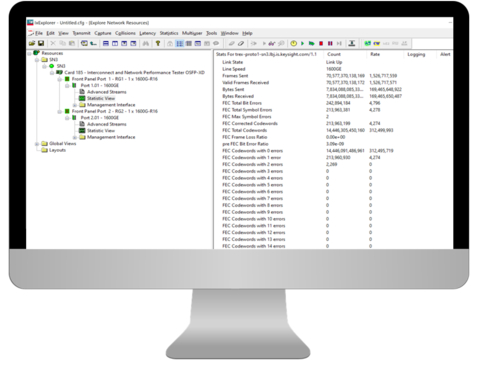Keysight Demonstrates First Full Line Rate 1.6 Terabit Ethernet Test Capability
- Keysight and Credo develop the first IEEE P802.3dj draft compliant 1.6 terabit media access control engine.
- The system can generate, receive, and measure 1.6 terabits of full line rate Ethernet layer 2 traffic.
- It showcases Keysight's innovation in ultra high-speed Ethernet traffic generation and measurement.
- The industry's first working 1.6 terabit Ethernet test and measurement system is developed by Keysight and Credo.
- The system can transmit and process over a billion packets per second, operating at full line rate.
- Network bandwidth demand is growing 30-40% annually, driven by data-intensive technologies like AI and video streaming.
- Keysight's 1.6T Layer 2 traffic generation system helps companies prepare for 1.6T adoption and enables early adopter testing.
- The system operates on an interface of 16 electrical lanes running at 106.25 Gbps per lane with FEC.
- FEC enhances data reliability by detecting and correcting errors during data transmission.
- Credo supports the buildout of a test and measurement ecosystem for the 1.6T networking standard.
- None.
Insights
The development of a 1.6 terabit Ethernet measurement system by Keysight Technologies in collaboration with Credo Semiconductor marks a significant leap in network technology. With the exponential growth in network bandwidth demand, primarily fueled by AI, cloud computing and video streaming, the industry is under pressure to enhance data throughput while maintaining power efficiency. This new system demonstrates the feasibility of 1.6T Ethernet speeds and provides a platform for testing next-generation network devices, which is essential for the development and quality assurance of high-speed networking equipment.
From a technical standpoint, the use of 16 electrical lanes with 106.25 Gbps per lane and PAM4 signaling represents a substantial advancement in serial-deserializer (SERDES) technology. The integration of Forward Error Correction (FEC) is also noteworthy, as it ensures data reliability over these high-speed connections. For network equipment manufacturers, this development could streamline the path to market for 1.6T products, ensuring that they meet the necessary performance benchmarks before deployment.
The strategic partnership between Keysight and Credo and their successful demonstration of a 1.6T Ethernet system is likely to have a positive impact on the market positions of both companies. Investors and stakeholders in the telecommunications sector should note the potential for increased demand for testing and measurement equipment as data centers and network operators prepare to upgrade to 1.6T capabilities. This demand is poised to grow as the adoption of AI and machine learning technologies continues to drive the need for higher network bandwidth.
Furthermore, this development could signal a shift in competitive dynamics within the industry, as companies that are first to market with 1.6T Ethernet solutions could gain a significant advantage. The ability to offer reliable, high-speed networking could become a key differentiator, potentially affecting market share and revenue growth for companies involved in network infrastructure.
In the context of data center operations, the transition to 1.6T Ethernet technology is not just about speed but also about efficiency and reliability. Data center operators are constantly balancing the need for more bandwidth with power and cooling constraints. The successful demonstration of a 1.6T Ethernet Layer 2 traffic generation and measurement system suggests that the industry is on track to deliver solutions that meet these requirements.
The operational benefits of such high-speed networks include improved support for data-intensive applications and the ability to handle the burgeoning volume of data traffic without proportional increases in energy consumption. This is critical for the sustainability of data centers, which are already under scrutiny for their environmental impact. Additionally, the integration of FEC is a key factor in ensuring the stability and resilience of network connections, which is paramount for data center reliability.
- Industry’s first IEEE P802.3dj draft compliant 1.6 terabit media access control engine developed by Keysight that can generate, receive, and measure 1.6 terabits (1600GE) of full line rate Ethernet layer 2 traffic
- Provides proof to the industry that a test and measurement hardware development platform can test early 1.6 terabit bandwidth-capable networking devices and interconnects.
- Real-world demonstration showcases Keysight’s innovation in achieving another industry first for ultra high-speed Ethernet traffic generation and measurement analysis

Keysight co-developed the industry’s first working 1.6 terabit Ethernet test and measurement system in a testbed with Credo Semiconductor. Running at full line rate, it can transmit and process more than a billion packets per second over a 2-meter active electrical cable – an unprecedented rate of speed. (Photo: Business Wire)
Network bandwidth demand continues to grow 30
To help data center operators overcome any potential hurdles, network equipment and chip manufacturers must:
- Deliver higher speed and data throughput without increasing data center power and cooling requirements
- Implement faster electrical lane speeds for the communication chips embedded in optical transceivers, switches, routers, servers, and test systems without compromising reliability or quality
- Measure the performance of silicon chips, network equipment, and network interconnection devices during their quality assurance (QA) cycle in final product benchmark testing
In recognizing the challenges of deploying 1.6T Ethernet, Keysight, developed the industry’s first working 1.6T Layer 2 traffic generation and measurement system, and is demonstrating it in a joint testbed with Credo. As 1.6T adoption gains momentum, establishing a testing framework early in the product development life cycle is critical to help speed time to market and enable confident deployment. Keysight, a leader in 400GE and 800GE testing is now helping companies prepare their 1.6T development plans and has the measurement systems needed for early adopter testing.
Highlights of the Keysight and Credo testbed demonstration include:
- Operational 1.6T Layer 2 engine – The engine operates on an interface of 16 electrical lanes running at 106.25 gigabits per second (Gbps) per lane with Pulse Amplitude Modulation 4 (PAM4) signaling and Forward Error Correction (FEC). This is also called 16 x 100G SERDES.
- Keysight hardware development test platform –With OSFP-XD front panel ports that can send and receive full line rate 1.6T layer 2 bi-directional traffic over a Credo provided 2-meter HiWire Active Electrical Cable (AEC). The 1.6T measurement system measures the performance of the link and the AEC.
-
Reliability with FEC – The Layer 2 engine running at full 1.6T line rate provides packet and FEC measurements, plus counters, and other related statistics. FEC enhances data reliability by detecting and correcting errors that occur during data transmission.
Manufacturers use these metrics during development and quality assurance testing to identify areas for improvement in device error correction performance and Ethernet link stability over time. End users can utilize FEC measurements to assess the resilience of network equipment under different stress conditions, so they can confidently deploy devices, interconnects, and networking equipment into their production networks.
Bill Brennan, Chief Executive Officer, Credo, said: “Credo launched the 1.6T HiWire AEC in support of our key customers’ product roadmaps in 2023 and it’s generated a great deal of industry interest. We’re excited to work with Keysight to support the buildout of a robust test and measurement ecosystem for this developing networking standard.”
Alan Weckel, Co-Founder and Analyst, 650 Group, said: “1.6T will be a critical speed to data center networking and key technology to the adoption of future AI / ML deployments. The Keysight 1.6T Ethernet Layer 2 traffic demonstration proves that the industry is getting ready to support next-generation workloads and move beyond 800 Gbps systems shipping now.”
Ram Periakaruppan, Vice President and General Manager, Network Test & Security Solutions, Keysight, said: “1.6T Ethernet is the next generation of Ethernet that addresses the demand for more network bandwidth and data throughput, driven in part, by ever-increasing AI workloads within the network infrastructure. The 1.6T Ethernet Layer 2 traffic generation and analysis demonstration moves the needle forward to enable development of 1.6T devices and the entire networking equipment ecosystem. Keysight’s Layer 2 and FEC test and measurement systems are also vital to the success of the eventual deployment of 1.6T capable networking devices and equipment.”
Resources
- Poster: Your Path to 1.6T
- Blog: 1.6 Terabit Ethernet will Drive Next-Generation AI/ML Wave and Accelerate Growth through 2030
About Keysight Technologies
At Keysight (NYSE: KEYS), we inspire and empower innovators to bring world-changing technologies to life. As an S&P 500 company, we’re delivering market-leading design, emulation, and test solutions to help engineers develop and deploy faster, with less risk, throughout the entire product life cycle. We’re a global innovation partner enabling customers in communications, industrial automation, aerospace and defense, automotive, semiconductor, and general electronics markets to accelerate innovation to connect and secure the world. Learn more at Keysight Newsroom and www.keysight.com.
View source version on businesswire.com: https://www.businesswire.com/news/home/20240319357034/en/
Paul Erwin
+1 248 430 9075
paul.erwin@keysight.com
Fusako Dohi
+81 42 660-2162
fusako_dohi@keysight.com
Jenny Gallacher
+44 (0) 7800 737 982
jenny.gallacher@keysight.com
Source: Keysight Technologies, Inc.







